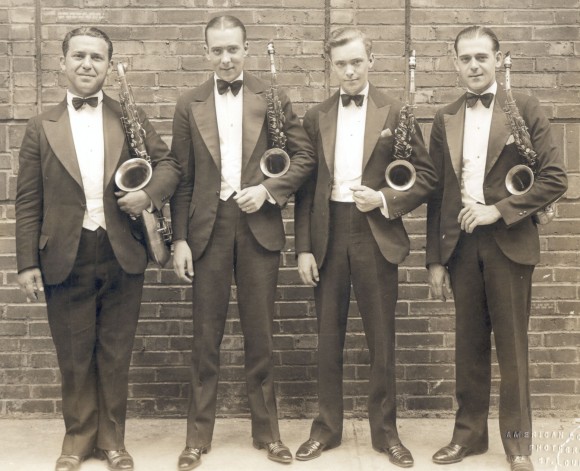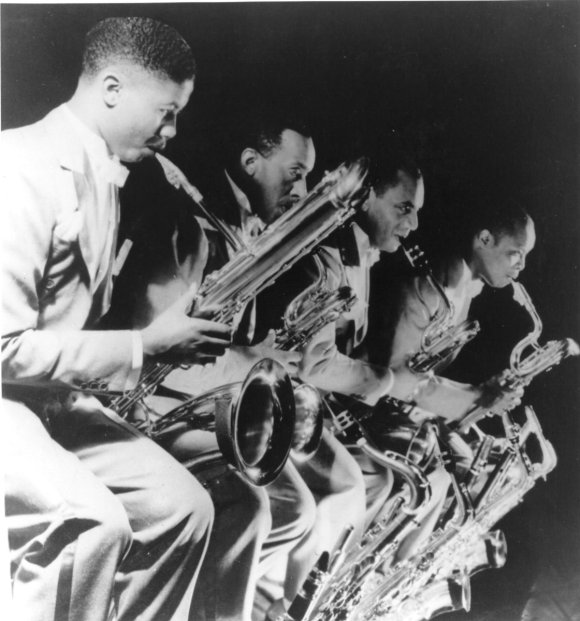 In trying to describe what makes Bennie Moten’s saxophone section so wonderfully different from any other in the continuum, I started to think about what jazz listeners have come to expect from the entity known as a “saxophone section.” The following began as an introduction for the Moten posts, went in its own direction and then turned into some random thoughts on this very important part of the jazz orchestra. The reader may be able to extract some larger point, or at the very least enjoy the music and photos.
In trying to describe what makes Bennie Moten’s saxophone section so wonderfully different from any other in the continuum, I started to think about what jazz listeners have come to expect from the entity known as a “saxophone section.” The following began as an introduction for the Moten posts, went in its own direction and then turned into some random thoughts on this very important part of the jazz orchestra. The reader may be able to extract some larger point, or at the very least enjoy the music and photos.
 Paul Whiteman called the saxophone section the string section of a big band. There’s more to his comparison than plush harmonies and fast scales. Just as the string section of a classical orchestra identifies the group as another link in a particular musical tradition, while distinguishing the best orchestras as unique members of that particular musical community, so does the saxophone section of a jazz big band. That’s not to diminish the distinct sound of a particular brass or rhythm section. Yet what instrument signifies “classical” like the violin, or “jazz” like the saxophone?
Paul Whiteman called the saxophone section the string section of a big band. There’s more to his comparison than plush harmonies and fast scales. Just as the string section of a classical orchestra identifies the group as another link in a particular musical tradition, while distinguishing the best orchestras as unique members of that particular musical community, so does the saxophone section of a jazz big band. That’s not to diminish the distinct sound of a particular brass or rhythm section. Yet what instrument signifies “classical” like the violin, or “jazz” like the saxophone?
 Think of Benny Goodman’s well-drilled but warm foursome under Hymie Schertzer’s transparent lead, or Earle Warren’s searing alto atop the twin tenors of Lester Young and Herschel Evans, with Jack Washington anchoring it all on baritone. Duke Ellington’s saxophone sections patched together various reeds in different combinations yet remained instantly recognizable despite, or because of, their versatility. Whiteman wasn’t just commenting on notes in a score or crafting good copy: how much does a single note from this instrumental part reveal about the musical whole?
Think of Benny Goodman’s well-drilled but warm foursome under Hymie Schertzer’s transparent lead, or Earle Warren’s searing alto atop the twin tenors of Lester Young and Herschel Evans, with Jack Washington anchoring it all on baritone. Duke Ellington’s saxophone sections patched together various reeds in different combinations yet remained instantly recognizable despite, or because of, their versatility. Whiteman wasn’t just commenting on notes in a score or crafting good copy: how much does a single note from this instrumental part reveal about the musical whole?
 The modern saxophone section lives and thrives by concerted blend and drive as well as the power of its soloists. Woody Herman’s “four brothers” section is best known for solos by Stan Getz, Zoot Sims, Herbie Steward, and Serge Chaloff, but their famous titular number shows how well they work(ed) together as well as individually. The best sax sections are their own band within a band. There’s enough differentiation of register and timbre between the two to three instruments that comprise the section to create a self-contained ensemble. At the same time, solid improvised solos splintering out of the unit are a given. Several “Meets the Sax Section” albums illustrate the idea, as well as how powerful that idea has remained for listeners.
The modern saxophone section lives and thrives by concerted blend and drive as well as the power of its soloists. Woody Herman’s “four brothers” section is best known for solos by Stan Getz, Zoot Sims, Herbie Steward, and Serge Chaloff, but their famous titular number shows how well they work(ed) together as well as individually. The best sax sections are their own band within a band. There’s enough differentiation of register and timbre between the two to three instruments that comprise the section to create a self-contained ensemble. At the same time, solid improvised solos splintering out of the unit are a given. Several “Meets the Sax Section” albums illustrate the idea, as well as how powerful that idea has remained for listeners.
 The swing era may not have introduced the concept of a saxophone section (which was already de rigueur for dance bands by the twenties), but it did codify a certain conception of it. From the big, rich sound of Count Basie’s new testament saxes, through the Thad Jones-Mel Lewis band grooving under Jerome Richardson’s greasy soprano, to the thick, ultra-precise reeds directed by Bob Mintzer and other contemporary players, there’s a clear expectation of what a saxophone section should “do,” which still allows individual texture and growth.
The swing era may not have introduced the concept of a saxophone section (which was already de rigueur for dance bands by the twenties), but it did codify a certain conception of it. From the big, rich sound of Count Basie’s new testament saxes, through the Thad Jones-Mel Lewis band grooving under Jerome Richardson’s greasy soprano, to the thick, ultra-precise reeds directed by Bob Mintzer and other contemporary players, there’s a clear expectation of what a saxophone section should “do,” which still allows individual texture and growth.
 Unlike the classical string section, where individual tone is incidental to the “ideal tone” taught and striven for in conservatories, the ideal tone in a jazz band is the musician’s tone. Individual timbres may balance one another but never disappear into the mix. Every metaphor has its limits…
Unlike the classical string section, where individual tone is incidental to the “ideal tone” taught and striven for in conservatories, the ideal tone in a jazz band is the musician’s tone. Individual timbres may balance one another but never disappear into the mix. Every metaphor has its limits…
